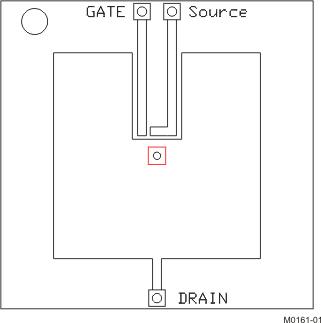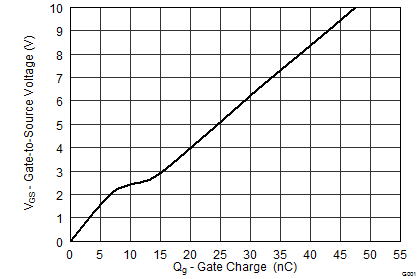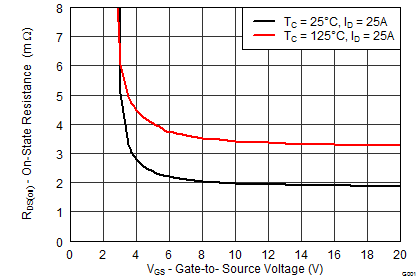SLPS489A June 2014 – August 2014 CSD17575Q3
PRODUCTION DATA.
- 1Features
- 2Applications
- 3Description
- 4Revision History
- 5Specifications
- 6Device and Documentation Support
- 7Mechanical, Packaging, and Orderable Information
パッケージ・オプション
デバイスごとのパッケージ図は、PDF版データシートをご参照ください。
メカニカル・データ(パッケージ|ピン)
- DQG|8
サーマルパッド・メカニカル・データ
発注情報
5 Specifications
5.1 Electrical Characteristics
(TA = 25°C unless otherwise stated)| PARAMETER | TEST CONDITIONS | MIN | TYP | MAX | UNIT | ||
|---|---|---|---|---|---|---|---|
| STATIC CHARACTERISTICS | |||||||
| BVDSS | Drain-to-Source Voltage | VGS = 0 V, ID = 250 μA | 30 | V | |||
| IDSS | Drain-to-Source Leakage Current | VGS = 0 V, VDS = 24 V | 1 | μA | |||
| IGSS | Gate-to-Source Leakage Current | VDS = 0 V, VGS = ±20 V | 100 | nA | |||
| VGS(th) | Gate-to-Source Threshold Voltage | VDS = VGS, ID = 250 μA | 1.1 | 1.4 | 1.8 | V | |
| RDS(on) | Drain-to-Source On-Resistance | VGS = 4.5 V, ID = 25 A | 2.6 | 3.2 | mΩ | ||
| VGS = 10 V, ID = 25 A | 1.9 | 2.3 | |||||
| gƒs | Transconductance | VDS = 3 V, ID = 25 A | 118 | S | |||
| DYNAMIC CHARACTERISTICS | |||||||
| CISS | Input Capacitance | VGS = 0 V, VDS = 15 V, ƒ = 1 MHz | 3400 | 4420 | pF | ||
| COSS | Output Capacitance | 393 | 511 | pF | |||
| CRSS | Reverse Transfer Capacitance | 157 | 204 | pF | |||
| Rg | Series Gate Resistance | 0.9 | 1.8 | Ω | |||
| Qg | Gate Charge Total (4.5 V) | VDS = 15 V, ID = 25 A | 23 | 30 | nC | ||
| Qgd | Gate Charge Gate-to-Drain | 5.4 | nC | ||||
| Qgs | Gate Charge Gate-to-Source | 8.5 | nC | ||||
| Qg(th) | Gate Charge at Vth | 4.6 | nC | ||||
| QOSS | Output Charge | VDS = 15 V, VGS = 0 V | 11.6 | nC | |||
| td(on) | Turn On Delay Time | VDS = 15 V, VGS = 4.5 V ID = 25 A RG = 2 Ω |
4 | ns | |||
| tr | Rise Time | 10 | ns | ||||
| td(off) | Turn Off Delay Time | 20 | ns | ||||
| tƒ | Fall Time | 3 | ns | ||||
| DIODE CHARACTERISTICS | |||||||
| VSD | Diode Forward Voltage | IS = 25 A, VGS = 0 V | 0.8 | 1 | V | ||
| Qrr | Reverse Recovery Charge | VDD = 15 V, IF = 25 A, di/dt = 300 A/μs | 15 | nC | |||
| trr | Reverse Recovery Time | 13 | ns | ||||
5.2 Thermal Information
(TA = 25°C unless otherwise stated)| THERMAL METRIC | MIN | TYP | MAX | UNIT | |
|---|---|---|---|---|---|
| RθJC | Junction-to-Case Thermal Resistance(1) | 1.5 | °C/W | ||
| RθJA | Junction-to-Ambient Thermal Resistance(1)(2) | 55 | |||
(1) RθJC is determined with the device mounted on a 1-inch2 (6.45-cm2), Cu pad on a 1.5-inches × 1.5-inches thick FR4 PCB. RθJC is specified by design, whereas RθJA is determined by the user’s board design.
(2) Device mounted on FR4 material with 1-inch2 2-oz.Cu.
 |
Max RθJA = 55°C/W when mounted on 1 inch2 of 2 oz. Cu. |
 |
Max RθJA = 160°C/W when mounted on minimum pad area of 2 oz. Cu. |
5.3 Typical MOSFET Characteristics
(TA = 25°C unless otherwise stated)


| ID = 25 A | VDS = 15 V | |

| ID = 250 µA | ||

| ID = 25 A | ||

| Single Pulse | Max RθJC = 1.5°C/W | |


| VDS = 5 V | ||



